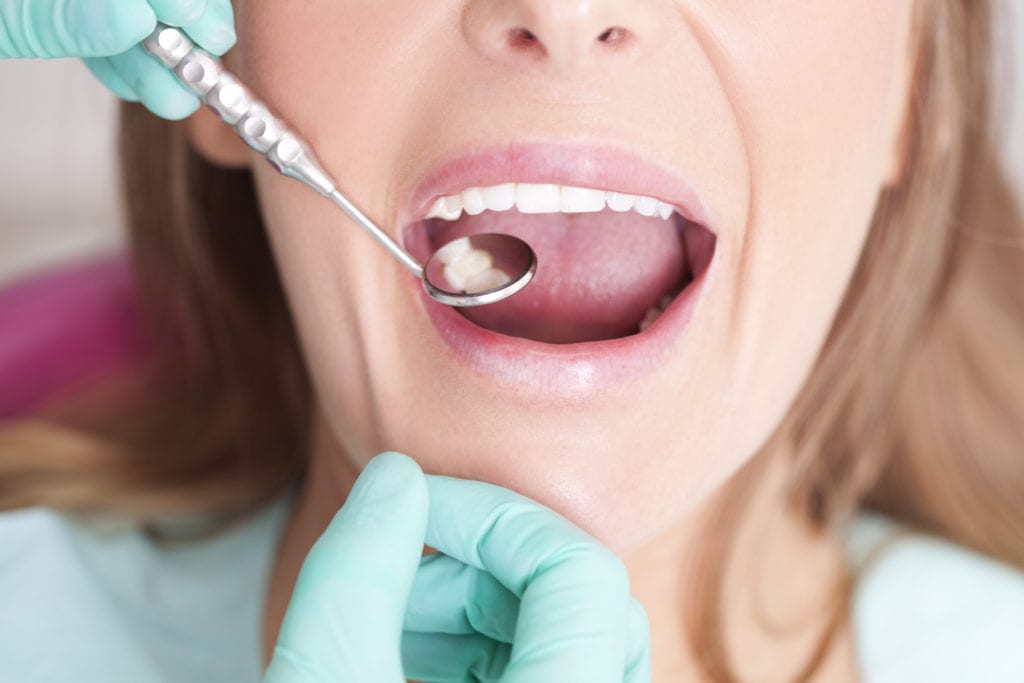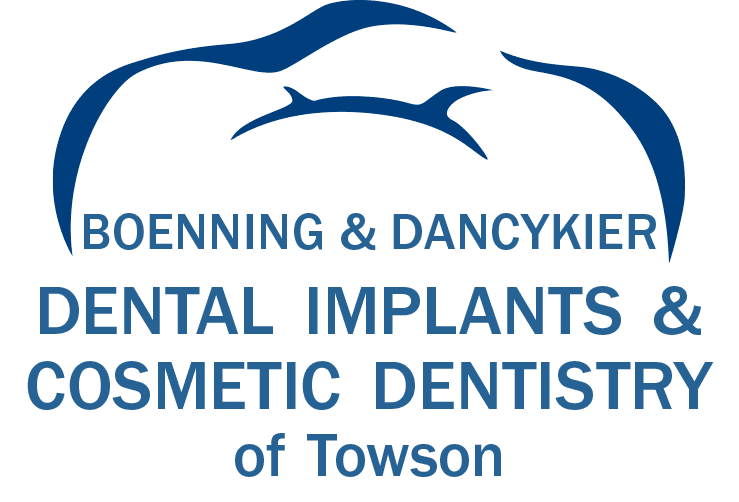Gum disease occurs because of plaque and bacteria buildup on and between the teeth. An overabundance of bacteria can lead to gum irritation. As gum disease or periodontitis progresses, the gum tissue recedes and compromises the stability of teeth. In severe cases of periodontitis, patients can even lose their teeth. Dr. Keith Boenning and Dr. Nathan Dancykier are dentists that offer treatment for periodontal disease in Towson, MD. Our dentists can help you restore the look and health of your gums.

Signs and Risk Factors of Gum Disease
Patients with gum disease can experience symptoms like red, bleeding, and inflamed gums. Gum recession or loose teeth can occur in later stages of gum disease. Multiple factors make some patients more prone to developing gum disease than others. These factors include:
- Poor Oral Hygiene: Daily brushing and flossing and regular dental cleanings and exams help remove plaque and bacteria that cause gum disease. Patients are more likely to develop gum disease if they skip brushing or don’t visit the dentist regularly. Common early signs of gum disease include bleeding gums and irritation.
- Misaligned Teeth: It’s more difficult to clean between crooked and misaligned teeth. Plaque can build up in hard-to-reach areas and lead to periodontitis.
- Smoking and Tobacco Products: Smoking slows the amount of oxygen in the blood. Smoking also slows the delivery of nutrients to the soft tissue in your gums. Using tobacco products or smoking prevents your body from effectively fighting off potential gum infections.
- Dry mouth: When the mouth does not produce enough saliva, it becomes a breeding ground for bacterial growth. Certain medications or medical conditions may cause dry mouth. Dry mouth can also lead to bad breath.
Taking the first steps like brushing and flossing every day, quitting smoking, and addressing dry mouth can reduce your risk of gum disease. But if you’re affected by any of these risk factors, we’re here to help. Our dentists can create a gum disease treatment plan to meet your needs.
Gum Disease Treatments in Towson, MD
Our dentists will examine your teeth and gums and may take X-rays to determine the extent of your infection. Then they’ll find the right option to address your gum disease symptoms. You have many options to address your gum problems. We may recommend one or more of these treatments to treat mild to severe forms of gum disease:
- Scaling and Root Planing: Scaling removes plaque and tartar beneath the gums for a deep clean. The goal is to remove all the plaque and tartar that have built up. These substances harbor bacteria that cause infections. Root planing smooths down the root portion of the teeth. This part of the procedure will help the gums reattach to the teeth.
- Pocket Reduction and Osseous Surgery: If your gum pockets are too deep to clean with scaling and root planing, we recommend a pocket reduction. This gum disease treatment will help our dentists thoroughly clean your gums. Periodontists often perform osseous surgery in tandem with pocket reduction surgery. This type of surgery helps to smooth down the jawbone so the gums can easily reattach.
- Gum and Bone Grafting: We recommend gum grafting to create a fuller gum line and protect your tooth roots. Leaving your roots exposed allows bacteria to penetrate the roots and can cause tooth loss. Severe gum disease can cause the jaw bone to deteriorate. Bone grafting is sometimes necessary to replace bone lost in the mouth and help restore strength to the jaw. We may suggest this procedure for dental implant patients who need more bone density to support the implant fixtures.
Our team will help you heal after your gum disease treatment. If you have chronic gum disease, we may recommend deep cleanings every 3 to 4 months. We want to keep your symptoms in check.
Patient Review
Frequently Asked Questions
Do you want to learn more about this disease and the treatments we offer? Read answers to common questions about gum disease treatment in our Towson, MD, dentist office.
What are the earliest signs that I have gum disease?
The earliest signs of gum disease are often easy to miss. You may notice your gums look red, swollen, or bleed when you brush or floss. You might also have bad breath that doesn’t go away or feel some tenderness in your gums. Call us as soon as you notice these symptoms. Early treatment can stop gum disease before it gets worse.
How painful is the periodontal treatment?
Periodontal treatment is usually not very painful. Most procedures, like deep cleanings or scaling and root planing, are done with local anesthesia to keep you comfortable. Some surgical treatments may cause mild soreness afterward, but your dentist will give you instructions and tips to manage any discomfort.
How long does it take to treat periodontal disease?
The time your dentist needs to address periodontal disease depends heavily on the stage of your periodontitis. Later stages of gum disease will require more time to get the infection under control and repair the damage. It’s easier to treat the early stages of infection and improve your gum health.
What lifestyle changes should I make after undergoing periodontal disease treatment?
Maintaining good oral hygiene habits and visiting your dentist regularly for check-ups help prevent gum disease from returning. You should also follow a healthy diet, quit smoking if you are a smoker, and reduce stress as much as possible. You can also take antibiotics to help your gums recover. Our dental team will help you manage your symptoms.
Does periodontal disease treatment hurt?
The level of pain and discomfort someone feels from periodontal disease treatment varies from patient to patient. Regardless, most dentists desire that patients are comfortable during any procedure performed in the dental office.
Periodontists focus on providing proper anesthetics and sedation during periodontal disease treatments if needed. This includes treatments such as scaling and root planing, pocket reduction surgery, or crown lengthening procedures.
How do scaling and root planing help treat periodontal disease?
Scaling and root planning are two of the most common treatments for periodontal disease. During scaling, our dental team will thoroughly clean your teeth below the gum line. We will remove both plaque and tartar buildup that can lead to infection and inflammation.
When we perform root planing, we smooth out any rough spots on your enamel, around the gum line. Bacteria have less of a chance of taking hold. You can get this treatment alone or in combination with other therapies based on the severity of your condition.
How does gum disease affect overall health?
The bacteria that inflame your gums can spread throughout your body and cause other health problems. When gum disease isn’t treated, the bacteria can enter your bloodstream and contribute to inflammation in other areas.
Studies have shown that gum disease is linked to conditions like heart disease, diabetes, and stroke. It may also make it harder for your body to control blood sugar or fight off infections. Taking care of your gums supports your overall health and well-being.
Can gum disease come back after treatment?
Yes. Gum disease can come back if you don’t take care of your teeth and gums after treatment. Brushing and flossing every day, visiting your dentist regularly, and keeping a healthy lifestyle can help prevent it from returning. Managing risk factors like smoking or diabetes also lowers your chances of gum disease coming back.
Book your Appointment Today
If you’re looking for gum disease treatment in Timonium and Towson, Maryland, call Dr. Keith Boenning and Dr. Nathan Dancykier at 410-324-2294. Request an appointment with our dentists on our website. We look forward to helping you restore your gums, mouth, and smile.
